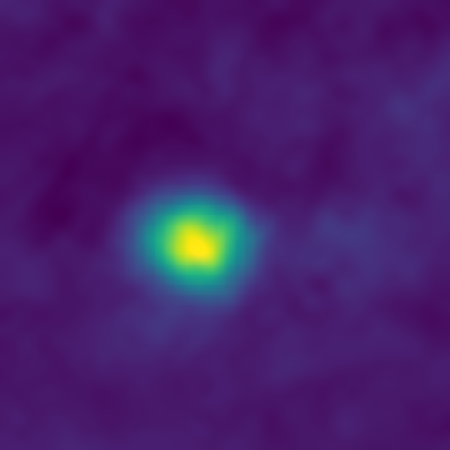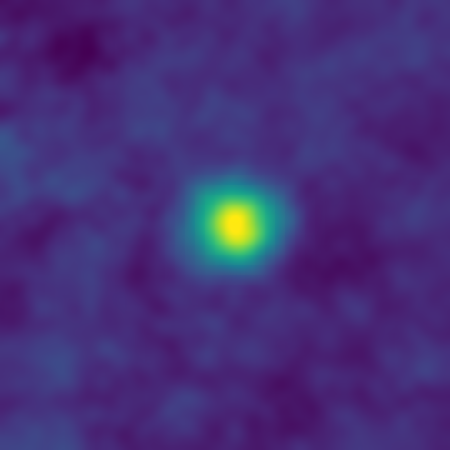
In the late 20th century, NASA’s Voyager 1 spacecraft took advantage of a rare alignment of outer planets to sweep past Jupiter, Saturn, Uranus and Neptune and dazzle us earthlings with never-before-imagined images. On February 14, 1990, the spacecraft looked back Earthward to create the famous Pale Blue Dot image, acquired when Voyager was 3.75 billion miles (6.06 billion km) from Earth. Afterwards, for 27 years, Voyager 1 held the record for being the most distant spacecraft from Earth while acquiring images. Now another spacecraft – New Horizons, which visited Pluto in 2015 – has beat Voyager’s record by capturing images at an even greater distance from Earth.
New Horizons acquired the routine calibration frame of the Wishing Well star cluster, above, on December 5, 2017. At that time, its distance from Earth was 3.79 billion miles (6.12 billion km). For several hours, the Wishing Well image – acquired with the Long Range Reconnaissance Imager (LORRI) – was the new farthest image ever made from Earth.
New Horizons broke its own record just two hours later with images of Kuiper Belt objects 2012 HZ84 and 2012 HE85 – which you can see below – further demonstrating, the mission team said in a statement:
… how nothing stands still when you’re covering more than 700,000 miles (1.1 million km) of space each day.
New Horizons Principal Investigator Alan Stern of the Southwest Research Institute in Boulder, Colorado, commented:
New Horizons has long been a mission of firsts — first to explore Pluto, first to explore the Kuiper Belt, fastest spacecraft ever launched. And now, we’ve been able to make images farther from Earth than any spacecraft in history.

During its extended mission in the Kuiper Belt, New Horizons hopes to observe at least two dozen Kuiper Belt objects (KBOs), dwarf planets and Ccntaurs, which are thought to be former KBOs in unstable orbits that cross the orbits of the giant planets. The recent New Horizons statement said:
… New Horizons has observed several KBOs and dwarf planets at unique phase angles, as well as centaurs at extremely high phase angles, to search for forward-scattering rings or dust.

What will happen now? Will every new image taken by New Horizons become the farthest image ever taken by a spacecraft? Yes, and no.
New Horizons is headed outward, toward the fringes of our solar system, but Earth’s movement in its yearly orbit around the sun affects the distance between us and the spacecraft, too. Right now, we and New Horizons are, more or less, on opposite sides of the solar system. But, as mission team member Cathy Olkin told EarthSky:
…as Earth revolves around the sun (to be on the same side of the sun and the spacecraft) the distance between us and the spacecraft becomes smaller. So any new images would not set a new record.
That’s one reason this spring and summer won’t be record-setting, with respect to images, for New Horizons. Plus … the spacecraft is currently hibernating, and new images aren’t being taken at this time. Instead of acquiring imagery, the team is currently collecting data on the plasma environment surrounding the spacecraft.
New Horizons is set to come out of hibernation on June 4.
And then its focus will be toward the KBO called 2014 MU69 – its next flyby target. Michael Buckley in the Office of Communications and Public Affairs at Johns Hopkins told EarthSky he believes that:
… attempts, at least, to image MU69 from New Horizons will begin in August. The long-range imager (LORRI) might not be able to resolve it yet.
However, sometime around then, when Earth has moved to a farther part of its orbit again with respect to the spacecraft … New Horizons will again begin breaking its own farthest-images record.
It’ll once more be acquiring images at ever-increasing distances from Earth.

Are there any plans to look back toward the inner solar system and Earth, and beat Voyager 1’s record of the farthest image ever taken of Earth?
Michael Buckley said no, there are, currently, no plans to turn the spacecraft “back” for an image of Earth or our solar system’s other major planets. He commented:
Earth, for example, is too close to the sun from New Horizons’ vantage point. Attempts to image it could damage the spacecraft’s sensitive cameras, which are set to operate in the dim conditions of the Kuiper Belt …

In the video below, Ann Druyan – Carl Sagan’s co-author and widow – reflects on the meaning of Voyager’s Pale Blue Dot image of Earth. Some of what she says applies to New Horizons now, too.
Bottom line: In December 2017, the New Horizons spacecraft broke the record for being at the greatest distance from Earth of any spacecraft while acquiring images.











